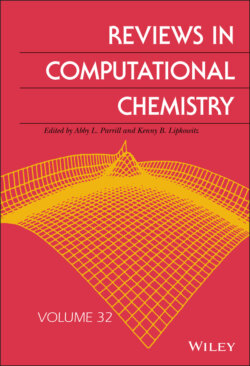Reviews in Computational Chemistry, Volume 32

Реклама. ООО «ЛитРес», ИНН: 7719571260.
Оглавление
Группа авторов. Reviews in Computational Chemistry, Volume 32
Table of Contents
List of Tables
List of Illustrations
Guide
Pages
REVIEWS IN COMPUTATIONAL CHEMISTRY, VOLUME 32
LIST OF CONTRIBUTORS
PREFACE
CONTRIBUTORS TO PREVIOUS VOLUMES
1 NON‐DETERMINISTIC GLOBAL STRUCTURE OPTIMIZATION: AN INTRODUCTORY TUTORIAL
LIST OF ABBREVIATIONS
INTRODUCTION. The Need for Structural Optimization
Search Space is Vast
Deterministic vs Non‐Deterministic Search
Fundamental Take‐Home Lessons
A CLOSER LOOK AT SOME NDGO BACKGROUND DETAILS. Too Inspired by Nature
No Free Lunch
NDGO Algorithm Comparisons
Barrier Crossing
Old vs New Machine Learning
Take‐Home Lessons for NDGO Background Details
GENERAL GUIDELINES FOR NDGO APPLICATIONS. Brief Summary of Some Fundamental NDGO Algorithm Ideas
NDGO Method Design Choices
NDGO Tips for Absolute Beginners
Things to Do, and Pitfalls to Avoid
RECENT HIGHLIGHTS
REFERENCES
Notes
2 DENSITY FUNCTIONAL TIGHT BINDING CALCULATIONS FOR PROBING ELECTRONIC‐EXCITED STATES OF LARGE SYSTEMS
INTRODUCTION
REAL‐TIME TIME‐DEPENDENT DFTB (RT‐TDDFTB) Theory and Methodology
Tutorial on RT‐TDDFTB Electron Dynamics for a Naphthalene Molecule
Absorption Spectrum for Naphthalene
Electron Dynamics of Naphthalene with a Laser‐Type Perturbation
RT‐TDDFTB Electron Dynamics of a Realistic Large Systems
Absorption Spectrum of a Single Plasmonic Nanoparticle
Exploring Excitation Energy Transfer in Ag Nanoparticle Chains
Analyzing the Electronic Couplings in NP Chains
Investigating the Nature of Plasmonic Excitations
DFTB‐BASED NONADIABATIC ELECTRON DYNAMICS. Adiabatic vs Nonadiabatic Dynamics
Equations Governing Nonadiabatic Electron Dynamics
The Classical Path Approximation
Surface Hopping and Fewest Switches Criterion
Implementation Details of CPA‐FSSH‐DFTB
Post‐processing Tools
COMPUTATIONAL DETAILS
AN EXAMPLE ON CHARGE TRANSFER DYNAMICS IN ORGANIC PHOTOVOLTAICS
CONCLUSION AND OUTLOOK
ACKNOWLEDGMENTS
REFERENCES
3 ADVANCES IN THE MOLECULAR SIMULATION OF MICROPHASE FORMERS
INTRODUCTION
Block Copolymers
Surfactants and Microemulsions
Lattice Spin Systems
Colloidal Suspensions
Other Examples
Field Theory of Microphase Formation
Molecular Simulations and Challenges
SIMULATING PERIODIC MICROPHASES
Expanded Thermodynamics
Thermodynamic Integration for Microphases
Ghost Particle/Cluster Switching Method
Cluster Volume Moves
Determining Phase Transitions
SIMULATIONS OF DISORDERED MICROPHASES
Wolff‐Like Cluster Algorithms
Virtual Cluster Moves
Aggregation Volume Biased (AVB) Moves
Morphological Crossovers in the Disordered Regime
MICROPHASE FORMERS SOLVED BY MOLECULAR SIMULATIONS
One‐Dimensional Models
Lattice Spin Models
Colloidal Models
CONCLUSION
3.A FREE ENERGY OF AN IDEAL GAS IN A FIELD
3.B CONSTANT PRESSURE SIMULATIONS OF PARTICLES IN A FIELD
3.C VIRIAL COEFFICIENTS OF PARTICLES IN A FIELD
ACKNOWLEDGMENTS
REFERENCES
4 MOLECULAR SIMULATIONS OF DEEP EUTECTIC SOLVENTS: A PERSPECTIVE ON STRUCTURE, DYNAMICS, AND PHYSICAL PROPERTIES
INTRODUCTION
DEEP EUTECTIC SOLVENTS. Definition of Deep Eutectic Solvents
DES as Ionic Liquid Analogues
Molecular Structure of DESs and Type of Interactions
Types of DES
MOLECULAR SIMULATION METHODS
An Overview of Ab Initio Methods
Classical Molecular Dynamics at the Atomic Level
Nonpolarizable Force Fields used for DES Simulations
PHYSICAL PROPERTIES. Liquid Density
Volume Expansivity
Surface Tension
THERMODYNAMIC PROPERTIES. Heat Capacity
Heats of Vaporization
Isothermal Compressibility
TRANSPORT PROPERTIES. Viscosity
Diffusion Coefficients
DEEP EUTECTIC SOLVENT STRUCTURE. Radial Distribution Functions
Hydrogen Bond Analysis
Spatial Distribution Functions
APPLICATION OF DES THROUGH SIMULATION. Gas Sorption Studies on DES
DES Interactions at Metal Surfaces
Proteins in DES
SUMMARY
ACKNOWLEDGMENTS
REFERENCES
NOTE
INDEX
WILEY END USER LICENSE AGREEMENT
Отрывок из книги
Edited by
ABBY L. PARRILL College of Arts and Sciences, The University of Memphis, Memphis, TN, USA
.....
Volume 16 (2000)
Richard A. Lewis, Stephen D. Pickett, and David E. Clark, Computer‐Aided Molecular Diversity Analysis and Combinatorial Library Design.
.....